 |
links to other FAQ pages
[ V8 Engine Fitting Information ]
[ Rover 3.5, 3.9, 4.2
to 4.6 Conversion ] [
LPG Conversion details ] [ Fuel Injection Section ]
[ Weber 500 & SU Carbs ]
[ Mallory Ignition
Systems ] [General
Engine Problems ] [
General Information ]

|
 |
| |

| Rover 4.6
Conversion from 3.5, 3.9, or 4.2 FAQ's |
|
You can download our latest V8 Engine brochure &
information here (Updated 2004)
<Click here>
|
|
 What parts will I need to
convert my existing engine to 4.6 ? What parts will I need to
convert my existing engine to 4.6 ? |
The
4.6 short engine includes: brand new cross-bolted block, new big journal
crankshaft, pistons and con-rods, high torque camshaft, new lifters, duplex
timing chain set and gaskets. This is the minimum requirement for a low-mileage
engine conversion from 3.5, 3.9 or 4.2. However, we do advise checking out the
likely condition of all other parts that you consider re-usable, You can find
this information on our general information pages.
|
|
 What do I need to up-rate
for my fuel injection? What do I need to up-rate
for my fuel injection? |
 Assuming your engine is fuel injected, there are essentially
three different types. Assuming your engine is fuel injected, there are essentially
three different types.
'Hot Wire' used from about 1985 (3.5, 3.9
& 4.2 litre USA), and from 1990 (3.9 and 4.2 litre UK). Because so much of
the engine fuelling is left to the ECU of these vehicles, it is almost
essential to fit our Tornado chip, this will not only achieve correct fueling
for your engine but will also achieve far better fueling than any of Rovers
best std. spec. efforts.
'Flapper
Type' preceded the 'Hot Wire' and still very popular, this system, only
requires ECU chipping if you are seeking maximum top-end or race power, as the
fuelling of these systems can be easily achieved using an improved (rising
rate) fuel pressure regulator, and, as this is much cheaper than re-chipping
these early ECUs, it is normally the best option. However, for serious
Power/Race engines we can, if required, supply re-chipped and fully adjustable
variants of this ECU.
'Gems'
identifiable by the absence of a conventional distributor (it has 8 coils
mounted on the back of the engine and uses optical ignition triggering) is in
short, 'very difficult'. This does not mean that we cannot do engine
conversions and performance upgrades for these engines, it just means it costs
more! We can supply ECU upgrades for these vehicles for power outputs up to
400bhp and 5.1 litre (more info soon). We have our own 4.0 undergoing a 4.8
conversion and will post all details on the web.
|
|
 What do I need to uprate for
my Carburettors? What do I need to uprate for
my Carburettors? |
 Assuming your engine is a
Carburettor type, there are many types. Assuming your engine is a
Carburettor type, there are many types.
'Weber 500' - in our
experience this is one of the best fuelling options for all V8s especially when
upgrading to 4.6 or considering other performance upgrades. This does not mean
you can't re-jet and re-use your existing Stromberg or SU Carbs, but it does
mean you are selling yourself short until you upgrade to the Weber. For
off-road, fast-road or even normal & high torque use, you can find all the
information on our Weber pages.
With all 4.6 and performance
upgrades, a KN free-flow Filter and Adjustable Fuel Pressure Regulator should
be added to your requirement list.
'Holley 390' - this carb
and its bigger brothers have for a long time been one of the more obvious
choices, mainly dictated by the fact that quad carb systems are very expensive
and no other budget price alternatives were available. However, now things have
changed and we would strongly suggest that the Weber is a far better up-to-date
option, or as an upgrade to fuel injection if you already have it.
'Zenith Strombergs and SUs' - these carburettors are standard
fitment on so many pre.-85 Rover V8s and, although it is possible to upgrade to
a 4.6 and retain these carburettors (by re-jetting), a very big slice of the
engine's Top- End performance will be lost (until you upgrade to the Weber). So
if you are seeking the best but cannot afford it all at once, then you can make
do with stock carb systems on a 4.6 conversion with the only losses being at
the higher RPM ranges.
'Quad down-draught Webers and Dellortos'
- we have not had (through choice) so much experience with these carburetor
systems, and nowadays the gains do not seem to be worth the huge expense,
difficulty and further costs of correct jetting of such multi-carb systems, as
these tend to be far more 'fussy' when it comes to keeping them at optimum
tuning.
'LPG' all capacity engine upgrades are suited to LPG
conversion and fuelling. The only issue is that your engine must be compatible
to run unleaded fuel and be fitted with the later oil-impregnated valve
guides.
|
|
 Can I use my
existing heads? Can I use my
existing heads? |
 Because the 4.6 Short engine
level option can, 'affordably' produce very high comparative levels of
torque, without going high into the top-end rpm ranges, replacing your
heads for high performance items is, although beneficial, not essential. This
is because the 4.6 engine can produce more power at 2000rpm than most standard
or tired engines will produce at 4500 rpm, Because the 4.6 Short engine
level option can, 'affordably' produce very high comparative levels of
torque, without going high into the top-end rpm ranges, replacing your
heads for high performance items is, although beneficial, not essential. This
is because the 4.6 engine can produce more power at 2000rpm than most standard
or tired engines will produce at 4500 rpm,
So head improvement is not
essential.
However, as standard heads are a very significant
performance compromise (even on standard engines), stage 1 (optimized) heads
would certainly produce big economy and further power gains when enlarging the
capacity or improving the performance/efficiency of your engine. So unless you
intend to build a high-spec. Kit Car or race engine, stage 1 unleaded heads (or
your own optimized) would be the best all round option.
|
|
 What if my engine is
higher mileage? What if my engine is
higher mileage? |
 Even though your engine is
higher mileage, if it is very clean due to long journeys and use of
extreme servicing and is still in very good order (see V8 general information),
it may be possible to achieve the conversion using only the parts mentioned
above, however if you are a little unsure of what is required then these
further improvements to the requirement list would be worthy of
consideration. Even though your engine is
higher mileage, if it is very clean due to long journeys and use of
extreme servicing and is still in very good order (see V8 general information),
it may be possible to achieve the conversion using only the parts mentioned
above, however if you are a little unsure of what is required then these
further improvements to the requirement list would be worthy of
consideration.
New Oil Pump Gears and Filter, new Oil Pump Base Plate,
New Rockers and Shafts, Unleaded Heads or rebuild kits to do your own. If your
requirement list is greater than this then the best option would be to opt for
our complete 4.6 engine as a drop-in replacement.
|
|
 What power gains should I
expect from the 4.6? What power gains should I
expect from the 4.6? |
 The main advantages are
best expressed when considering the substantial torque increase and huge
additional strength of this engine due to being crossbolted and using a larger
journal crank. Apart from giving you a 'new' engine, the 4.6 engine conversion
is excellent for instantly responsive, more effortless acceleration, pulling,
and overtaking, and, except when required, all RPi Engines are designed for
Road & Fast-Road use so engine idle is improved and smoother, whilst
achieving excellent fuel economy when driven accordingly (assuming you don't
find it difficult to resist all those horses and can keep your foot off the
floor boards). You can see from the power figure from our Stage 3, 4.6 engine,
that even at this level there are no losses, only gains (check out the huge
torque all the way from 1500rpm to 5500 rpm., and you can still expect an
optimum 22mpg and more. The main advantages are
best expressed when considering the substantial torque increase and huge
additional strength of this engine due to being crossbolted and using a larger
journal crank. Apart from giving you a 'new' engine, the 4.6 engine conversion
is excellent for instantly responsive, more effortless acceleration, pulling,
and overtaking, and, except when required, all RPi Engines are designed for
Road & Fast-Road use so engine idle is improved and smoother, whilst
achieving excellent fuel economy when driven accordingly (assuming you don't
find it difficult to resist all those horses and can keep your foot off the
floor boards). You can see from the power figure from our Stage 3, 4.6 engine,
that even at this level there are no losses, only gains (check out the huge
torque all the way from 1500rpm to 5500 rpm., and you can still expect an
optimum 22mpg and more.
|
|
 What approximate mpg, under
normal conditions, can I expect? What approximate mpg, under
normal conditions, can I expect? |
 From our experience smaller
3.5 engines would struggle to produce high power at lower rpm (demanding
much harder driving styles, using higher rpm for gear shifts
etc) From our experience smaller
3.5 engines would struggle to produce high power at lower rpm (demanding
much harder driving styles, using higher rpm for gear shifts
etc)
Therefore a far torquer 4.6 will not normally use more fuel, indeed
the lack of wide open throttle position to achieve higher power levels and the
improvments gained by a new engine could even increase the efficiency levels
way beyond that of a tired 3.5.
|
|
 Will my manual
transmission take the extra power of a 4.6? Will my manual
transmission take the extra power of a 4.6? |
 We have found with all the
conversions we have fitted or supplied that, except when 'Racing' is
required, the transmissions of most V8 powered vehicles would be unaffected
unless already in poor condition. We would stress that all existing
transmissions would best be replaced if high mileage and in poor condition, but
normally a minimum of a major service (partial strip down, new oil and
adjustments) would suffice. We have found with all the
conversions we have fitted or supplied that, except when 'Racing' is
required, the transmissions of most V8 powered vehicles would be unaffected
unless already in poor condition. We would stress that all existing
transmissions would best be replaced if high mileage and in poor condition, but
normally a minimum of a major service (partial strip down, new oil and
adjustments) would suffice.
|
|
 Will my auto transmission
take the extra power of a 4.6? Will my auto transmission
take the extra power of a 4.6? |
 This conversion is
excellent for auto transmission as the extra torque delivered by the 4.6
gives much smoother and more powerful acceleration, so the engine does not need
to use high revs to reach cruising speeds. This conversion is
excellent for auto transmission as the extra torque delivered by the 4.6
gives much smoother and more powerful acceleration, so the engine does not need
to use high revs to reach cruising speeds.
You can expect all 4WD
vehicles to reach 60mph in well under 10 seconds without pushing hard. We
would, however, recommend that all high-mileage and early transmissions should
have the torque converter reconditioned with a higher stall speed to achieve
best results.
|
|
 Why does my
mechanic say I cannot convert to 4.6? Why does my
mechanic say I cannot convert to 4.6? |
 This is a common
misunderstanding. When you look at the Rover 4.6 HSE engine (the origin of
this conversion) you will notice many changes from your V8 engine. Rover have
used what is called a 'Gems' Engine Management System and this employs a
totally different injection and ignition system (many of which are giving
problems far beyond the capabilities of the main agents). This is a common
misunderstanding. When you look at the Rover 4.6 HSE engine (the origin of
this conversion) you will notice many changes from your V8 engine. Rover have
used what is called a 'Gems' Engine Management System and this employs a
totally different injection and ignition system (many of which are giving
problems far beyond the capabilities of the main agents).
But the
beauty of this conversion is that you are only using the 4.6 short engine (and
or heads) which is totally compatible with all previous V8 engines and engine
components, so everything you have already will not only fit straight onto a
4.6 short or full engine, but they are also very compatible to achieving the
power gains that are readily available from this conversion.
Quick
|Links
| Re-chipping |
|
 Do I need to
re-chip My 3.9 or 4.2 hot wire injection system for my upgrade? Do I need to
re-chip My 3.9 or 4.2 hot wire injection system for my upgrade?
Chipping is essential if it's already
really bad (weak) running the stock 3.9 or 4.2 chip, as the stock chip is even
weak on a std. 3.9 through the mid range.
The 4.6 upgrade needs a Tornado
chip upgrade (cheaper power-only chip options are available but lack efficiency
and tight control of fueling throughout the entire rev range).
The 4.6 air
mass meter would also help but without knowing your vehicle, its use and how
much you want to achieve, I would need to know if you have done stage 1 or
stage 3 work to the heads, and what about intake ports, trumpets and plenum
throttle body size, these are of secondary importance.
(see below)
1. Chipping
2. Head mods
3 Intake mods inc. big throttle
body
4. Air mass meter upgrades 1-4 ignition mods can be slotted in
anywhere in the general scheme of things if you want the best from your
conversion.
|
| Exhausts |
|
 I have stainless steel performance
exhaust manifolds. Are they a good item for the 4.6l. ?. I have stainless steel performance
exhaust manifolds. Are they a good item for the 4.6l. ?.
Perfect
for the Job.
|
| Injection systems/fuel pressure |
|
 What's the ideal, '4.6' upgrade spec.. for my
early type 3.5 injection system. What's the ideal, '4.6' upgrade spec.. for my
early type 3.5 injection system.
My advice, if
you want Stage 3 or beyond for a street car, would be perhaps a 4.6 balanced
engine taken to Stage 3, with intake manifold porting, shortened trumpets
(matched) and big plenum, the ECU. upgrade to 'EVO 4', recon. injectors etc., a
Jag air flow meter, and Mallory or upgraded electronic distributor with
Magnecor leads.
Another (better) option, would be to use a 3.9
injection system upgraded and re-chipped, or Weber 600 Carb Kit.
|
 Is there any
modification to do on my injection system? Is there any
modification to do on my injection system?
Reconditioning the injectors (ultrasonic
cleaning) would be appropriate, chipping is also advisable but not so
important. If running on LPG. (gas) all other parts of the system need at least
checking.
|
 Is
the Fuel Pressure Regulator different between a 4.6L and a 3.9L engine? Is
the Fuel Pressure Regulator different between a 4.6L and a 3.9L engine?
With regards to the factory supplied equipment the engines
use different regulators, so you would not be able to use your original 3.9L
one. What we suggest you do is upgrade to our (FSE) adjustable pressure
regulator.
|
 Do I have to have
the injection system changed to 3.5 type? Do I have to have
the injection system changed to 3.5 type?
No, but
it will be straining it mostly due to the age and condition of all its
components, some get through easily, others show up new problems.
As a
minimum, you would be well advised to have the injectors ultrasonically
cleaned, as they will be at least 20% down on original efficiency (and we need
20% more) with a poor spray pattern. We can do this for you if you send them
in. If not replaced already, these early injection systems will need to have a
'rising rate' adjustable fuel pressure regulator fitted, this will step up not
only the injection rail pressure but will also increase fuel pressure
incrementally higher than the std. unit and for most less demanding
systems/conversions, is all that is needed to make it work well.
|
| Ignition |
|
 Will the original Ignition module
that feeds the distributor be sufficient for the 4.6L engine? Will the original Ignition module
that feeds the distributor be sufficient for the 4.6L engine?
Yes, but we would suggest using the RPi Power Amp this
replaces the ignition module. The ignition module can be completely removed and
then kept in a safe place, so that in the unlikely event that the power amp
does fail then you can re-install the Ignition module and as RPi actually
builds the power amp we will be able to fix it if it is sent to us.
|
| Cylinder heads |
|
 Could I keep my old cylinder heads and, if yes, is
there some modification to do on them? Could I keep my old cylinder heads and, if yes, is
there some modification to do on them?
If very low mileage
and in superb shape (late date, normally '95 on with later seal and valve guide
type) check & re-fit as they are, otherwise recondition them and use our
rebuild kits which are supplied with the latest unleaded seals and
guides.
|
| Short Long or Turnkey engine |
|
 Short Engine, Long Engine, Turnkey Engine Short Engine, Long Engine, Turnkey Engine
Just
a guide, due to so many variations.
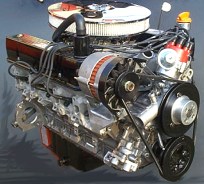 |
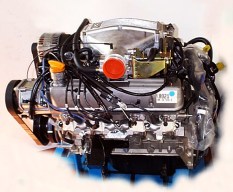 |
Turnkey Engine with Mallory ignition and Weber 500 plus all
ancillary. |
Turnkey Engine with hot wire injection and serpentine front
end. |
| |
|
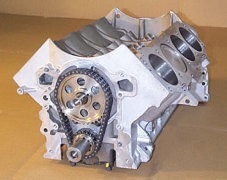 |
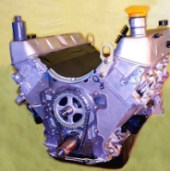 |
Short Engine. All capacities, 3.5, 3.9, 4.0, 4.6, 4.8, 4.9
& 5.2 litre available. |
Long engine. Sometimes referred to as a 'stripped
engine' |
|
 What's best for
me, a 4.6 'short' engine or a 'long' engine? What's best for
me, a 4.6 'short' engine or a 'long' engine?
Basically there are
two levels at which you can do this.
If your existing engine is in
really good shape when you strip it down you could do it at short engine level,
this means a new 4.6 short and you re-use your heads, rocker gear etc.
At
this level you could indeed assume more labour at your end, less warranty from
our end, but in all cases so far, if your engineer is competent, add a new oil
pump base, a pair of oil pump gears, rockers, rocker shafts and push rods,
check your heads or improve as you wish, and you've got a good budget 4.6
upgrade.
If you don't want the hassle or your engine is showing some
wear, then a long engine is best. You will still need oil pump gears and base,
but you will get a less questioned warranty and simplicity of installation
(plus a whole new warranted engine that has to be the best option).
Both
are appropriate, but the answer to your question has to be based on how easy or
how cheap you want it. A long engine has a better warranty from us as we supply
it all and can be more sure of things, a short engine is reliant on parts from
your existing engine that may be detrimental to its reliability, especially
parts that might send up more engine swarf, like rockers and shafts and the oil
pump base and gears.
So if using the short engine only it is important, if
higher mileage, to replace both these items.
Also, re-using heads is not
such a big problem, but later new heads have to be a better choice. So our
advice would always be a long engine, but your budget constraints may dictate
we use a short engine and add some additional bits to it.
|
| Power and Torque |
|
 What power and torque can be
expected What power and torque can be
expected
It will always depend on how well you get it set up
and the use of all other original or replaced components it has to rely on, but
a std. 4.6 will have pretty much the same torque and bhp. shape as a stage 3
but would be about 15-20%. less at the top end.
|
Dyno
comparison 4.0 and 4.6
Below, you can see a std. 4.6 graph for
std. & Stage 3. It's interesting to see how it's only the upper end that
seriously gains from the stage 3 upgrade.
http://www.v8engine.com/engine-2.htm
will take you to the relevant page.
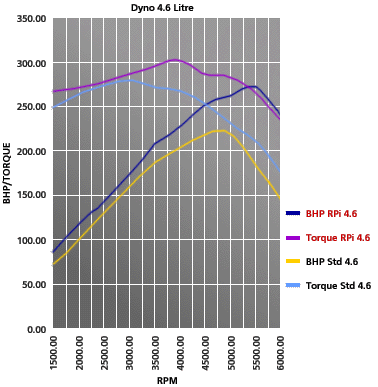
|
| Other |
|
 What's the issue with re-using my rockers, rocker
shafts and push rods? What's the issue with re-using my rockers, rocker
shafts and push rods?
On a
very low-mileage, very clean engine this would be OK, but if your rocker shafts
are already showing signs of 'scoring' (you can easily check by pulling back
one of the rockers and looking at the underneath of the shaft) then it means
your rockers are already contaminated with engine swarf (metallic particles
stuck in the soft alloy rockers) so fitting just new shafts will only create
new swarf to mess up your new short engine, so a new set is
recommended.
|
 Should I need or prefer a 4.6 Short Engine or Long
Engine for my upgrade Should I need or prefer a 4.6 Short Engine or Long
Engine for my upgrade
Basically there are two levels at which you
can do this. If your existing engine is in really good shape when you strip it
down you could do it at short engine level, this means a new 4.6 short and you
re-use your heads, rocker gear etc.
At this level you could assume more
labour at your end, less warranty from our end, but in all cases if your
engineer is competent then add a new oil pump base, a pair of oil pump gears,
rockers, rocker shafts and push rods, then check your heads or improve as you
wish and you've got a good budget 4.6 upgrade.
If you don't want the
hassle, or your engine is showing some wear, then a complete engine might be
the best option. You will still need oil pump gears and base, but you will get
a less questioned warranty and simplicity of installation (plus a whole new
warranted motor which has to be the best option).
Both are appropriate,
but the answer to your question has to be based on how easy or how cheap
you want it. A long engine has a better warranty from us as we supply it all
and can be more sure of things. A short engine is reliant on parts from your
existing engine that might be detrimental to its reliability, especially parts
that will send up more engine swarf, such as rockers and shafts and the oil
pump base and gears. So, if using the short engine only, it is important (if
higher mileage) to replace both these items. Re-using heads is not a big
problem but later new heads have to be the better choice, so our advice always
would be a long engine. But your budget constraints may dictate we use a short
engine and add some additional bits to it.
|
 What
else is worth considering if my engine is in reasonable shape? What
else is worth considering if my engine is in reasonable shape?
The oil pump is the
heart of all engines, so new oil-pump gears, a new oil pump base, and check the
condition of the timing cover that contains the oil pump gears, apart from the
obvious need to create good oil pressure in your new
engine.
|
 Could I
keep my 3.5 or 3.9 oil pan, oil pump, and in general all engine ancillaries
without modification? Could I
keep my 3.5 or 3.9 oil pan, oil pump, and in general all engine ancillaries
without modification?
Yes, no problem, but ensure their re-use is
spotlessly clean. Also you will need to check the crankshaft clearance and
modify/relieve if appropriate.
|
 How
long does it take? How
long does it take?
At engine level, how long can depend on how bad
your existing engine is, but you can count on at least 8 extra hours to build
up an engine and add its ancillaries, with cleaning painting and other relevant
preparation work, also with all the best intentions it is wise to be very sure
about the heads' condition before they are refitted. On a higher mileage engine
bearing this in mind, unless you are using your own free labour, it can often
work out better to go for a long engine in the first place.
|
|
|
|
links to other FAQ pages
[ V8 Engine Fitting Information ]
[ Rover 3.5, 3.9, 4.2
to 4.6 Conversion ] [
LPG Conversion details ] [ Fuel Injection Section ]
[ Weber 500 & SU Carbs ]
[ Mallory Ignition
Systems ] [ General
Engine Problems ] [
General Information ] |
|
Prices do not include local EU.Tax.(VAT).
Prices & stock are subject
to change without notice. Information and advice, as always, is free.
|
|
|
|